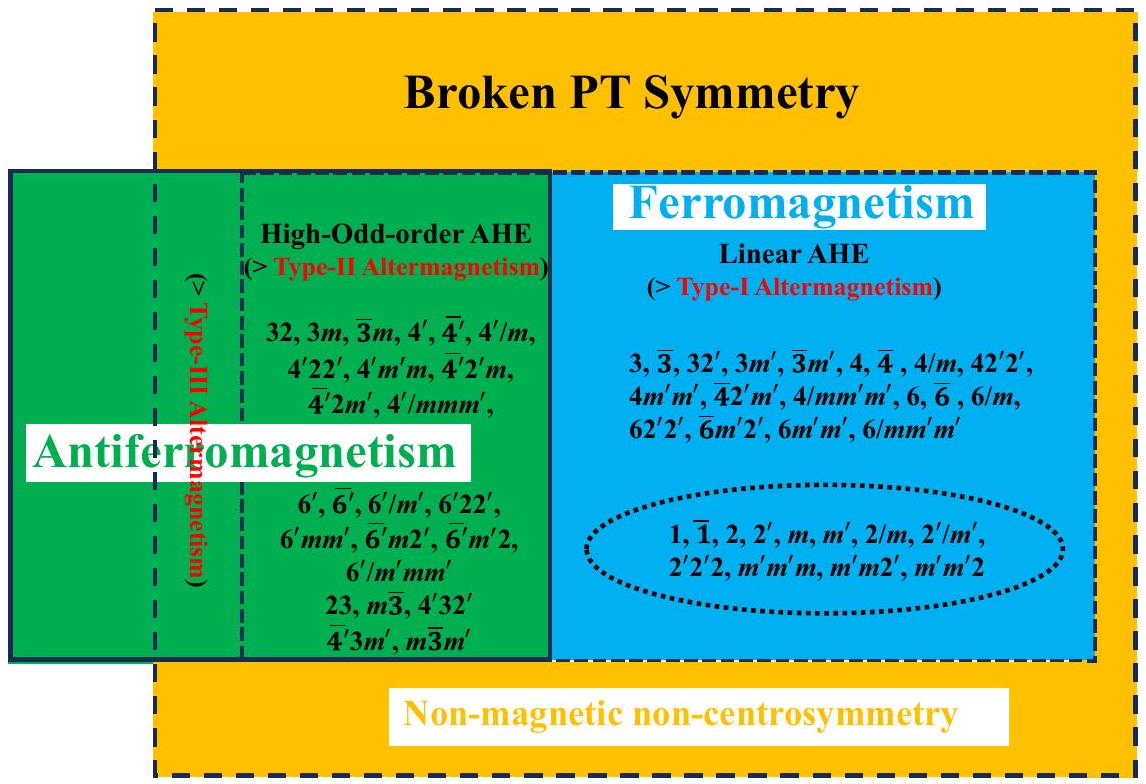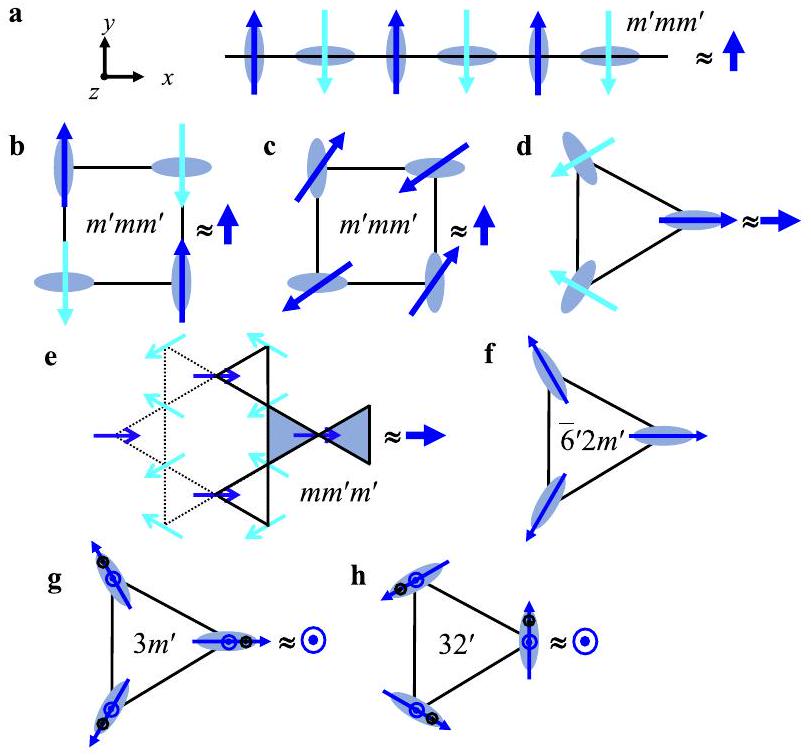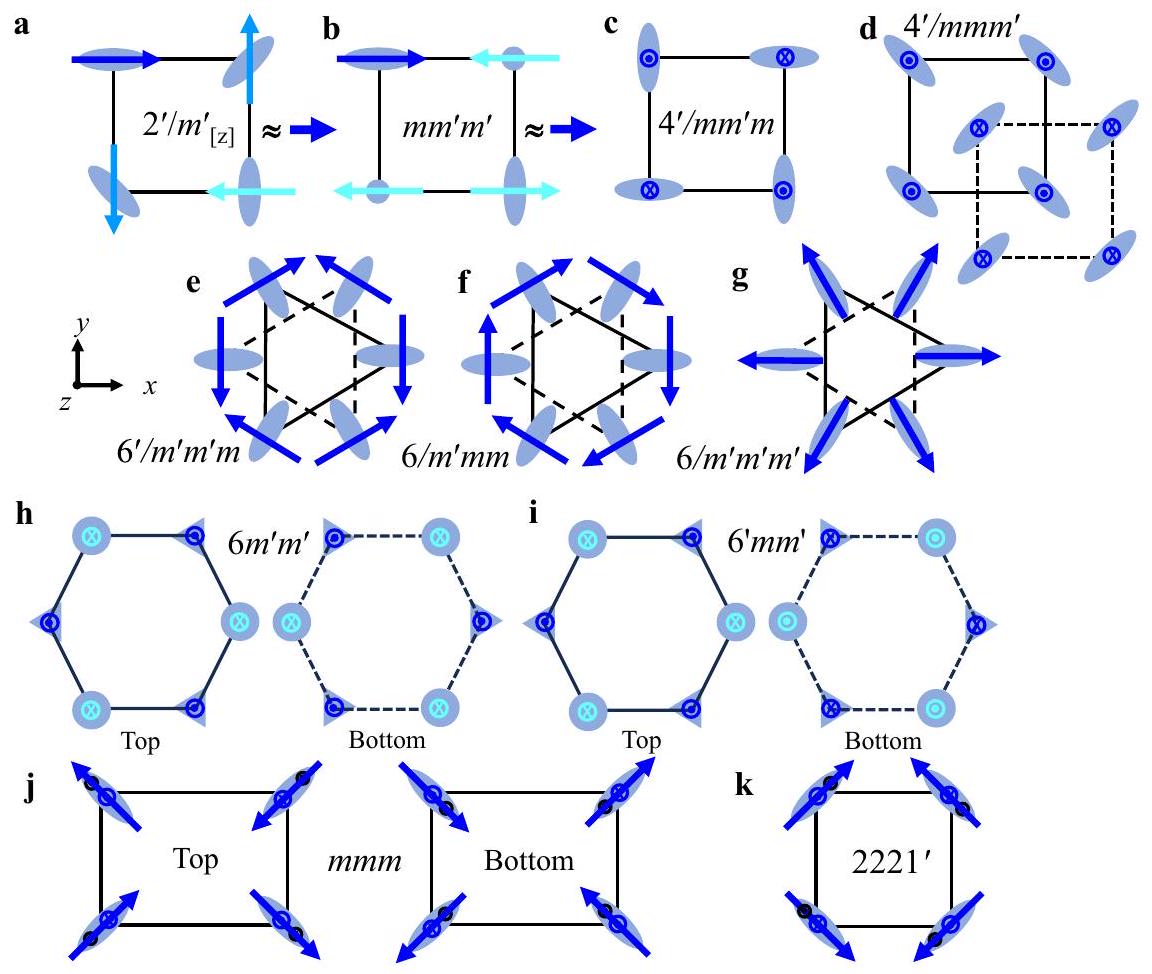DOI: https://doi.org/10.1038/s41535-024-00626-6
تاريخ النشر: 2024-01-22
المغناطيسية البديلة مع دوران غير متوازي
الملخص
يتم تقديم الألترمغناطيسية كفئة من الحالات المغناطيسية ذات الدوران المضاد “المتوازي” والتغيرات المتناوبة للهياكل المحلية حول الدورانات بطريقة تسمح بالتناظر الذي يتيح سلوكيات مغناطيسية حديدية نموذجية. يتبين أن الألترمغناطيسيات التي تظهر سلوكيات مغناطيسية حديدية دون أي اضطرابات خارجية (النوع الأول) تنتمي إلى مجموعة النقاط المغناطيسية الحديدية. يمكن أن تحتوي الألترمغناطيسيات الأخرى (النوع الثاني والنوع الثالث) على سلوكيات مغناطيسية حديدية فقط مع الاضطرابات الخارجية مثل التيار الكهربائي أو الضغط، والتي تحافظ على تناظر عكس الزمن-التماثل (PT). جميع أنواع الألترمغناطيسيات نفسها لديها كسر في تناظر PT. يمكن توسيع مفهوم الألترمغناطيسية لاستيعاب الدورانات غير المتوازية وتنوعات الهياكل المحلية المتعددة.
مقدمة
المغناطيسية الحديدية مقابل المغناطيسية المضادة
تشابه (SOS) مع

المغناطيسية البديلة من النوع الأول والنوع الثاني
التيار الحراري، الإضاءة الضوئية أو الضغط. يتبين أن كل من المغناطيسات البديلة من النوع الأول والنوع الثاني لديها تماثل PT مكسور. لاحظ أن الاضطرابات الخارجية مثل التيارات الكهربائية/الحرارية المطبقة، الإضاءة الضوئية، أو الضغط لا تكسر تماثل PT بنفسها، ولكن، على سبيل المثال، الحقول الكهربائية أو الحقول المغناطيسية المطبقة تكسر تماثل PT. كما نؤكد أن الإعداد التجريبي بالكامل، الذي يجمع بين مغناطيس بديل من النوع الثاني مع تماثل PT المكسور واضطراب خارجي مع تماثل PT غير المكسور، لديه الآن SOS مع

والمغنطة المستحثة على طول
تغيير المغناطيسية مع سبين غير متوازي

الحالة المغناطيسية في الشكل 3i مع
ظواهر ذات صلة مثل المغنطة الناتجة عن التيار من الرتبة الفردية القطرية، المغنطة الناتجة عن التيار من الرتبة الفردية غير القطرية، التأثير الهول الكمي من الرتبة الزوجية، إلخ. أحد أمثلة المغناطيسات البديلة من النوع الثالث موضح في الشكل 3j (MPG mmm)، والذي لديه تماثل PT مكسور ولكنه لا يظهر أي من الظواهر المذكورة أعلاه، على الأقل، على طول أي محور رئيسي.
الاستنتاج
تم النشر عبر الإنترنت: 22 يناير 2024
REFERENCES
- Baltz, V. et al. Antiferromagnetic spintronics. Rev. Mod. Phys. 90, 015005 (2018).
- Hirohata, A. et al. Review on spintronics: principles and device applications. J. Magn. Magn. Mater. 509, 166711 (2020).
- Jungwirth, T., Marti, X., Wadley, P. & Wunderlich, J. Antiferromagnetic spintronics. Nat. Nanotechnol. 11, 231-241 (2016).
- Wolf, S. A. et al. Spintronics: a spin-based electronics vision for the future. Science 294, 1488-1495 (2001).
- Cheong, S.-W., Thompson, J. D. & Fisk, Z. Metamagnetism in
. Phys. Rev. B 39, 4395-4398 (1989). - Baibich, M. N. et al. Giant magnetoresistance of (001)
magnetic superlattices. Phys. Rev. Lett. 61, 2472-2475 (1988). - Fert, A. Nobel lecture: Origin, development, and future of spintronics Nobel lecture: origin, development, and future of spintronics. Rev. Mod. Phys. 80, 1517-1530 (2008).
- Binasch, G., Grünberg, P., Saurenbach, F. & Zinn, W. Enhanced magnetoresistance in layered magnetic structures with antiferromagnetic interlayer exchange. Phys. Rev. B 39, 4828-4830 (1989).
- Šmejkal, L., MacDonald, A. H., Sinova, J., Nakatsuji, S. & Jungwirth, T. Anomalous Hall antiferromagnets. Nat. Rev. Mater. 7, 482-496 (2022).
- Šmejkal, L., Mokrousov, Y., Yan, B. & MacDonald, A. H. Topological antiferromagnetic spintronics. Nat. Phys. 14, 242-251 (2018).
- Wadley, P. et al. Electrical switching of an antiferromagnet. Science 351, 587-590 (2016).
- Chen, H., Niu, Q. & Macdonald, A. H. Anomalous Hall effect arising from noncollinear antiferromagnetism. Phys. Rev. Lett. 112, 017205 (2014).
- Kübler, J. & Felser, C. Non-collinear antiferromagnets and the anomalous Hall effect. Europhys. Lett. 108, 67001 (2014).
- Nakatsuji, S., Kiyohara, N. & Higo, T. Large anomalous Hall effect in a non-collinear antiferromagnet at room temperature. Nature 527, 212-215 (2015).
- Mazin, I. Editorial: Altermagnetism-a new punch line of fundamental magnetism. Phys. Rev. X 12, 040002 (2022).
- Šmejkal, L., Sinova, J. & Jungwirth, T. Emerging research landscape of altermagnetism. Phys. Rev. X 12, 040501 (2022).
- Šmejkal, L., Sinova, J. & Jungwirth, T. Beyond conventional ferromagnetism and antiferromagnetism: a phase with nonrelativistic spin and crystal rotation symmetry. Phys. Rev. X 12, 031042 (2022).
- Šmejkal, L. et al. Crystal time-reversal symmetry breaking and spontaneous Hall effect in collinear antiferromagnets. Sci. Adv. 6, eaaz8809 (2020).
- McClarty, P. A. & Rau, J. G. Landau theory of altermagnetism. https://arxiv.org/abs/ 2308.04484 (2023).
- Hayami, S., Yanagi, Y. & Kusunose, H. Bottom-up design of spin-split and reshaped electronic band structures in antiferromagnets without spin-orbit coupling: Procedure on the basis of augmented multipoles. Phys. Rev. B 102, 144441 (2020).
- Gonzalez Betancourt, R. D. et al. Spontaneous anomalous Hall effect arising from an unconventional compensated magnetic phase in a semiconductor. Phys. Rev. Lett. 130, 036702 (2023).
- Cheong, S.-W. & Huang, F.-T. Trompe L’oeil Ferromagnetism: magnetic point group analysis. npj Quant. Mater. 8, 73 (2023).
- Cheong, S.-W., Huang, F.-T. & Minhyong, K. Linking emergent phenomena and broken symmetries through one-dimensional objects and their dot/cross products. Rep. Prog. Phys. 85, 124501 (2022).
- Birss, R. R. in Symmetry and Magnetism. 125-138 (North-Holland Pub. Co., 1964).
- Cheong, S.-W. SOS: symmetry-operational similarity. npj Quant. Mater. 4, 53 (2019).
- Cheong, S.-W. Trompe L’oeil Ferromagnetism. npj Quant. Mater. 5, 37 (2020).
- Gallego, S. V. et al. MAGNDATA: towards a database of magnetic structures. I.The commensurate case. J. Appl. Crystallogr. 49, 1750-1776 (2016).
- Landau, L. D. & Lifshitz, E. M. in Electrodynamics of Continuous Media, Vol. 8. (eds. Landau L. D. & Lifshitz E. M.) 130-179, Ch. V (Pergamon,1984).
- Shuvalov, L. A. Modern crystallography. IV. Physical properties of crystals. 1-46 (Springer England, 1989).
- Higo, T. et al. Large magneto-optical Kerr effect and imaging of magnetic octupole domains in an antiferromagnetic metal. Nat. Photonics 12, 73-78 (2018).
- Ikhlas, M. et al. Piezomagnetic switching of the anomalous Hall effect in an antiferromagnet at room temperature. Nat. Phys. 18, 1086-1093 (2022).
- Hohenberg, P. C. Existence of long-range order in one and two dimensions. Phys. Rev. 158, 383-386 (1967).
- Mermin, N. D. & Wagner, H. Absence of ferromagnetism or antiferromagnetism in one- or two-dimensional isotropic Heisenberg models. Phys. Rev. Lett. 17, 1133-1136 (1966).
- Mazin, I. I. Altermagnetism in MnTe: origin, predicted manifestations, and routes to detwinning. Phys. Rev. B 107, L100418 (2023).
- Wang, H. et al. Giant anisotropic magnetoresistance and nonvolatile memory in canted antiferromagnet
. Nat. Commun. 10, 2280 (2019). - Kotegawa, H. et al. Large anomalous Hall effect and unusual domain switching in an orthorhombic antiferromagnetic material NbMnP. npj Quant. Mater. 8, 56 (2023).
- Disa, A. S. et al. Polarizing an antiferromagnet by optical engineering of the crystal field. Nat. Phys. 16, 937-941 (2020).
- Moriya, T. Piezomagnetism in
. J. Phys. Chem. Solids 11, 73-77 (1959). - Liu, J. & Balents, L. Anomalous Hall effect and topological defects in antiferromagnetic Weyl semimetals:
. Phys. Rev. Lett. 119, 087202 (2017). - Nayak, A. K. et al. Large anomalous Hall effect driven by a nonvanishing Berry curvature in the noncolinear antiferromagnet
. Sci. Adv. 2, e1501870 (2016). - Brown, P. J. & Chatterji, T. Neutron diffraction and polarimetric study of the magnetic and crystal structures of
and . J. Phys. Condens. Matter 18, 10085-10096 (2006). - Das, H., Wysocki, A. L., Geng, Y., Wu, W. & Fennie, C. J. Bulk magnetoelectricity in the hexagonal manganites and ferrites. Nat. Commun. 5, 2998 (2014).
- Du, K. et al. Vortex ferroelectric domains, large-loop weak ferromagnetic domains, and their decoupling in hexagonal (Lu, Sc)FeO3. npj Quant. Mater. 3, 33 (2018).
- Park, P. et al. Field-tunable toroidal moment and anomalous Hall effect in noncollinear antiferromagnetic Weyl semimetal
TaS .npj Quant. Mater. 7, 42 (2022). - Kurumaji, T., Ishiwata, S. & Tokura, Y. Diagonal magnetoelectric susceptibility and effect of Fe-doping in a polar ferrimagnet
. Phys. Rev. B 95, 045142 (2016). - Wang, Y. et al. Unveiling hidden ferrimagnetism and giant magnetoelectricity in polar magnet
. Sci. Rep. 5, 12268 (2015).
الشكر والتقدير
مساهمات المؤلفين
المصالح المتنافسة
معلومات إضافية
© المؤلفون 2024
مركز روتجرز للمواد الناشئة وقسم الفيزياء وعلم الفلك، جامعة روتجرز، بيسكاتاواي، نيو جيرسي 08854، الولايات المتحدة الأمريكية. البريد الإلكتروني: sangc@physics.rutgers.edu
DOI: https://doi.org/10.1038/s41535-024-00626-6
Publication Date: 2024-01-22
Altermagnetism with non-collinear spins
Abstract
Altermagnetism is introduced as a category of magnetic states with ‘collinear’ antiferromagnetic spins and alternating variations of local structures around spins in such a way that the symmetry allows typical ferromagnetic behaviors. Altermagnets exhibiting ferromagnetic behaviors without any external perturbations (type-l) turn out to belong to the ferromagnetic point group. Other altermagnets (type-II and type-III) can have ferromagnetic behaviors only with external perturbations such as electric current or stress, which conserve parity-time-reversal (PT) symmetry. All types of altermagnets themselves have broken PT symmetry. The concept of altermagnetism can be extended to accommodate non-collinear spins and multiple local-structure variations.
INTRODUCTION
FERROMAGNETISM VS. ANTIFERROMAGNETISM
similarity (SOS) with

TYPE-I AND TYPE-II ALTERMAGNETISM
thermal current, light illumination or stress. It turns out that both type-I and type-II altermagnets do have broken PT symmetry. Note that external perturbations such as applied electric/thermal currents, light illumination, or stress themselves do not break the PT symmetry, but, for example, applied electric fields or magnetic fields do break the PT symmetry. We also emphasize that the entire experimental set-up, combining a type-II altermagnet with the broken PT symmetry and an external perturbation with the unbroken PT symmetry, now has SOS with

and induced magnetization along
ALTERMAGNETISM WITH NON-COLLINEAR SPINS

the magnetic state in Fig. 3i with
relevant phenomena such as diagonal odd-order current-induced magnetization, off-diagonal odd-order current-induced magnetization, even-order AHE, etc. One example of type-III altermagnets is shown in Fig. 3j (MPG mmm), which has broken PT symmetry but does not exhibit any of the phenomena listed above, at least, along any principal
CONCLUSION
Published online: 22 January 2024
REFERENCES
- Baltz, V. et al. Antiferromagnetic spintronics. Rev. Mod. Phys. 90, 015005 (2018).
- Hirohata, A. et al. Review on spintronics: principles and device applications. J. Magn. Magn. Mater. 509, 166711 (2020).
- Jungwirth, T., Marti, X., Wadley, P. & Wunderlich, J. Antiferromagnetic spintronics. Nat. Nanotechnol. 11, 231-241 (2016).
- Wolf, S. A. et al. Spintronics: a spin-based electronics vision for the future. Science 294, 1488-1495 (2001).
- Cheong, S.-W., Thompson, J. D. & Fisk, Z. Metamagnetism in
. Phys. Rev. B 39, 4395-4398 (1989). - Baibich, M. N. et al. Giant magnetoresistance of (001)
magnetic superlattices. Phys. Rev. Lett. 61, 2472-2475 (1988). - Fert, A. Nobel lecture: Origin, development, and future of spintronics Nobel lecture: origin, development, and future of spintronics. Rev. Mod. Phys. 80, 1517-1530 (2008).
- Binasch, G., Grünberg, P., Saurenbach, F. & Zinn, W. Enhanced magnetoresistance in layered magnetic structures with antiferromagnetic interlayer exchange. Phys. Rev. B 39, 4828-4830 (1989).
- Šmejkal, L., MacDonald, A. H., Sinova, J., Nakatsuji, S. & Jungwirth, T. Anomalous Hall antiferromagnets. Nat. Rev. Mater. 7, 482-496 (2022).
- Šmejkal, L., Mokrousov, Y., Yan, B. & MacDonald, A. H. Topological antiferromagnetic spintronics. Nat. Phys. 14, 242-251 (2018).
- Wadley, P. et al. Electrical switching of an antiferromagnet. Science 351, 587-590 (2016).
- Chen, H., Niu, Q. & Macdonald, A. H. Anomalous Hall effect arising from noncollinear antiferromagnetism. Phys. Rev. Lett. 112, 017205 (2014).
- Kübler, J. & Felser, C. Non-collinear antiferromagnets and the anomalous Hall effect. Europhys. Lett. 108, 67001 (2014).
- Nakatsuji, S., Kiyohara, N. & Higo, T. Large anomalous Hall effect in a non-collinear antiferromagnet at room temperature. Nature 527, 212-215 (2015).
- Mazin, I. Editorial: Altermagnetism-a new punch line of fundamental magnetism. Phys. Rev. X 12, 040002 (2022).
- Šmejkal, L., Sinova, J. & Jungwirth, T. Emerging research landscape of altermagnetism. Phys. Rev. X 12, 040501 (2022).
- Šmejkal, L., Sinova, J. & Jungwirth, T. Beyond conventional ferromagnetism and antiferromagnetism: a phase with nonrelativistic spin and crystal rotation symmetry. Phys. Rev. X 12, 031042 (2022).
- Šmejkal, L. et al. Crystal time-reversal symmetry breaking and spontaneous Hall effect in collinear antiferromagnets. Sci. Adv. 6, eaaz8809 (2020).
- McClarty, P. A. & Rau, J. G. Landau theory of altermagnetism. https://arxiv.org/abs/ 2308.04484 (2023).
- Hayami, S., Yanagi, Y. & Kusunose, H. Bottom-up design of spin-split and reshaped electronic band structures in antiferromagnets without spin-orbit coupling: Procedure on the basis of augmented multipoles. Phys. Rev. B 102, 144441 (2020).
- Gonzalez Betancourt, R. D. et al. Spontaneous anomalous Hall effect arising from an unconventional compensated magnetic phase in a semiconductor. Phys. Rev. Lett. 130, 036702 (2023).
- Cheong, S.-W. & Huang, F.-T. Trompe L’oeil Ferromagnetism: magnetic point group analysis. npj Quant. Mater. 8, 73 (2023).
- Cheong, S.-W., Huang, F.-T. & Minhyong, K. Linking emergent phenomena and broken symmetries through one-dimensional objects and their dot/cross products. Rep. Prog. Phys. 85, 124501 (2022).
- Birss, R. R. in Symmetry and Magnetism. 125-138 (North-Holland Pub. Co., 1964).
- Cheong, S.-W. SOS: symmetry-operational similarity. npj Quant. Mater. 4, 53 (2019).
- Cheong, S.-W. Trompe L’oeil Ferromagnetism. npj Quant. Mater. 5, 37 (2020).
- Gallego, S. V. et al. MAGNDATA: towards a database of magnetic structures. I.The commensurate case. J. Appl. Crystallogr. 49, 1750-1776 (2016).
- Landau, L. D. & Lifshitz, E. M. in Electrodynamics of Continuous Media, Vol. 8. (eds. Landau L. D. & Lifshitz E. M.) 130-179, Ch. V (Pergamon,1984).
- Shuvalov, L. A. Modern crystallography. IV. Physical properties of crystals. 1-46 (Springer England, 1989).
- Higo, T. et al. Large magneto-optical Kerr effect and imaging of magnetic octupole domains in an antiferromagnetic metal. Nat. Photonics 12, 73-78 (2018).
- Ikhlas, M. et al. Piezomagnetic switching of the anomalous Hall effect in an antiferromagnet at room temperature. Nat. Phys. 18, 1086-1093 (2022).
- Hohenberg, P. C. Existence of long-range order in one and two dimensions. Phys. Rev. 158, 383-386 (1967).
- Mermin, N. D. & Wagner, H. Absence of ferromagnetism or antiferromagnetism in one- or two-dimensional isotropic Heisenberg models. Phys. Rev. Lett. 17, 1133-1136 (1966).
- Mazin, I. I. Altermagnetism in MnTe: origin, predicted manifestations, and routes to detwinning. Phys. Rev. B 107, L100418 (2023).
- Wang, H. et al. Giant anisotropic magnetoresistance and nonvolatile memory in canted antiferromagnet
. Nat. Commun. 10, 2280 (2019). - Kotegawa, H. et al. Large anomalous Hall effect and unusual domain switching in an orthorhombic antiferromagnetic material NbMnP. npj Quant. Mater. 8, 56 (2023).
- Disa, A. S. et al. Polarizing an antiferromagnet by optical engineering of the crystal field. Nat. Phys. 16, 937-941 (2020).
- Moriya, T. Piezomagnetism in
. J. Phys. Chem. Solids 11, 73-77 (1959). - Liu, J. & Balents, L. Anomalous Hall effect and topological defects in antiferromagnetic Weyl semimetals:
. Phys. Rev. Lett. 119, 087202 (2017). - Nayak, A. K. et al. Large anomalous Hall effect driven by a nonvanishing Berry curvature in the noncolinear antiferromagnet
. Sci. Adv. 2, e1501870 (2016). - Brown, P. J. & Chatterji, T. Neutron diffraction and polarimetric study of the magnetic and crystal structures of
and . J. Phys. Condens. Matter 18, 10085-10096 (2006). - Das, H., Wysocki, A. L., Geng, Y., Wu, W. & Fennie, C. J. Bulk magnetoelectricity in the hexagonal manganites and ferrites. Nat. Commun. 5, 2998 (2014).
- Du, K. et al. Vortex ferroelectric domains, large-loop weak ferromagnetic domains, and their decoupling in hexagonal (Lu, Sc)FeO3. npj Quant. Mater. 3, 33 (2018).
- Park, P. et al. Field-tunable toroidal moment and anomalous Hall effect in noncollinear antiferromagnetic Weyl semimetal
TaS .npj Quant. Mater. 7, 42 (2022). - Kurumaji, T., Ishiwata, S. & Tokura, Y. Diagonal magnetoelectric susceptibility and effect of Fe-doping in a polar ferrimagnet
. Phys. Rev. B 95, 045142 (2016). - Wang, Y. et al. Unveiling hidden ferrimagnetism and giant magnetoelectricity in polar magnet
. Sci. Rep. 5, 12268 (2015).
ACKNOWLEDGEMENTS
AUTHOR CONTRIBUTIONS
COMPETING INTERESTS
ADDITIONAL INFORMATION
© The Author(s) 2024
Rutgers Center for Emergent Materials and Department of Physics and Astronomy, Rutgers University, Piscataway, NJ 08854, USA. email: sangc@physics.rutgers.edu
